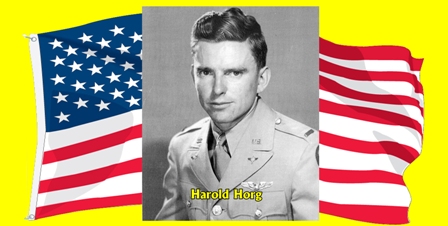|
PROFILE OF A MUSEUM VOLUNTEER HAROLD HORG
Harold Horg
was born January 11, 1923 in Fresno, California to an immigrant family of
Russian-German decent. The area where
he lived as a young man was affectionately called "Roosian
Town" by its residents. After
graduation from Edison High School, he attended Fresno State College (Now
CSUF) from 1940 to 1943. In October of
1942 at age 19, Harold enlisted in the Army Air Corps as a cadet. He was called to duty in March of 1943,
doing one month of boot camp in Lincoln, Nebraska. He was then sent to Montana University in
Missoula, Montana April 10, 1943, and stayed until June 1943. This location was used as a holding pattern
for the Army Air Corp to control the influx of personnel to the training
bases for Aviation Cadets.
In July 1943, Harold was sent to
Santa Ana Air Base for pre-flight training that he completed in September
1943. From there, he was transferred
to Santa Maria on the California south coast for primary flight training
which he completed in November of 1943.
Harold was then transferred to Lemoore Air Base in Central California,
near his hometown, for basic flight training and assigned to single engine
aircraft. Upon completion, he was
transferred to Luke Field in Phoenix, Arizona for advanced single engine
flight training. That training included aerial gunnery (fixed) plus flying
time in a Curtis P-40 Warhawk fighter aircraft, an
airplane already famous for being part of the Flying Tigers under General
Chennault.
Graduating on May 23, 1944, Harold
received his pilot wings and was awarded a commission as a Second
Lieutenant. He was promoted to fighter
pilot of single engine aircraft. Harold
received orders he was to be a flight instructor at Luke Field, instructing
aviation cadets. He stayed at that
assignment until he received orders to report to Columbia Air Base in South
Carolina. There Harold started
training with twin engine aircraft B-25 Mitchell Bombers. Aircraft crews of six were established for
each B-25 Bomber. On November 21,
1944, his group was ordered to Greenville Air Base to begin training for B-25
combat flying. All of the groups
training ended on February 26, 1945 and were reassigned to Muroc Air Base (Now Edwards Air Force Base) in
California. They joined the 41st Bomb
Group of the 7th Air Corps. His group
was then forwarded to Salinas Air Base in a holding pattern where they
received their overseas combat equipment.
They continued on to Seattle P.O.E., where they were loaded with their
aircraft on a ship sailing to Hawaii.
After a seven-day cruise, they landed in Oahu at Wheeler Field. In
only a short time, Barking Sands in Kaui became
their final station, while they awaited orders to go into combat with their
B-25 Bombers.
To their relief, the war ended
abruptly when two atomic bombs were dropped on Hiroshima and Nagasaki,
Japan. However, Harold's outfit was
instructed to cross the Pacific and landed at Clark Air Base on Luzon in the
Philippines. They continued on,
joining the 85th fighter wing of the 13th Air Corps, at Nielsen Field on
Manila. Harold’s outfit of B-25 crews
were broken up and assigned odds and ends duty until June 6, 1946. Harold was then sent home, arriving in
Oakland, California at the de-embarkation station for discharging.
Following his release from duty
Harold joined the Air Corps Reserves on July 1, 1946 and served for 5 years
with no recall to active duty. During
this same time, Harold completed college in June 1947 earning a BA degree in
accounting. Upon graduation, he
pursued his accounting career for 50 years before retiring. He is married to LaVerne
and they have five children and six grandchildren. Harold enjoys gardening and holds a master
gardeners certificate he received through hard work and training with Cal
State University – Fresno. He is
considered an expert on the subject.
Harold has served as a docent at the Legion of Valor Museum since 1998
and enjoys his time there very much. |

